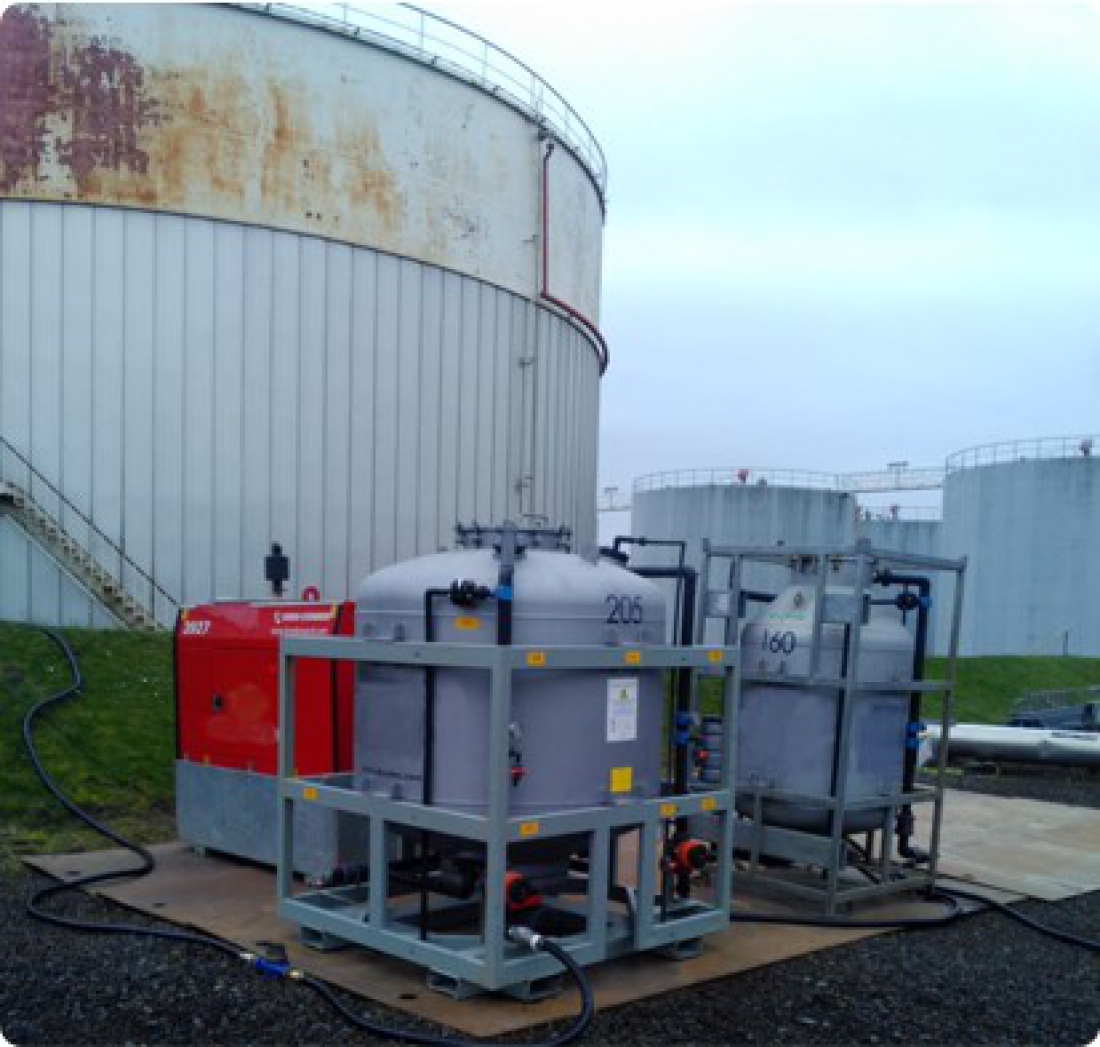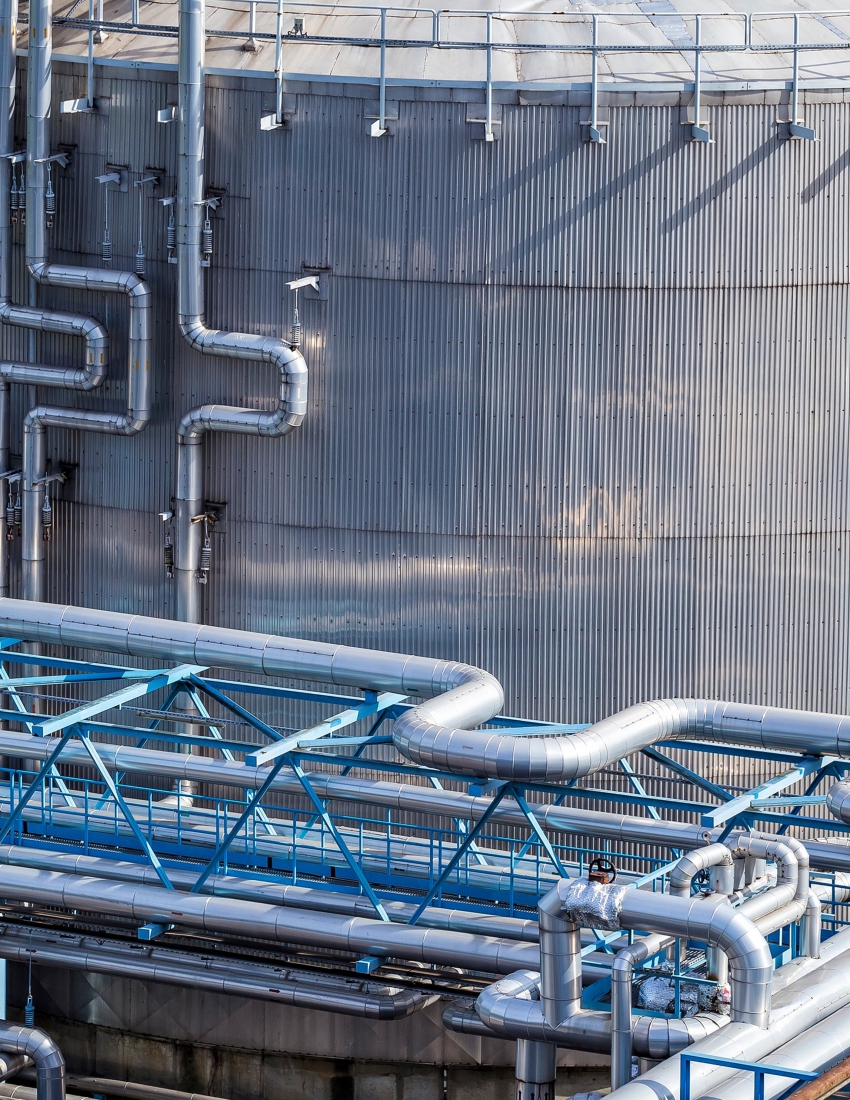Treatment of fire fighting water - terminal Amsterdam
The project
During an incident at an oil terminal in Amsterdam, a release of around 500m³ of firefighting water containing firefighting foam occurred. The firefighting foam was of the AFFF type, which means it contains PFAS in high amounts.
PFAS is hazardous to humans and the environment. Directly after the release, the client performed the appropriate emergency response. The diluted firefighting foam was pumped into an unused storage tank. The regulatory body demanded an on-site treatment of the contaminated water stream. The normal procedure, which includes the transportation of the water to a certified waste processor, was not allowed due to the presence of the PFAS.
The regulatory body agreed to an on-site treatment with granular activated carbon (GAC) as the preferred adsorbent. Arcadis was selected to prepare and execute the project. The team gave extra attention to the proper treatment of the spent activated carbon. The carbon was then regenerated for renewed use.
The project consisted of:
- The analyses of the firefighting water (PFAS and other known contaminants);
- Calculation of the amount of GAC needed to remove the PFAS;
- Engineering of the treatment plant;
- Preparation of the project (considering the high-safety standard in the zoned area);
- Installation of the treatment plant;
- Treating the water;
- Sampling and analyses; and
- Reporting.
Points of attention
Effectively treating firefighting water containing firefighting foam is a challenge. With this, it is important to make sure that the PFAS adsorbed onto the GAC is completely destroyed in the process of regeneration. The use of mobile GAC vessels provided by the GAC producer was the preferred option, thus safeguarding the proper processing of the GAC. Upon the regeneration of the GAC, the desorbed PFAS was disintegrated at a high temperature.
What are we proud of?
We succeeded to complete the project within a very short timeframe. We were also able to execute the project whilst being compliant with the strict safety rules. Overall, the chosen method of action was very effective. Upon treatment, the PFAS concentrations in the firefighting water reduced by more than 99,5% (independent assessment). Ultimately, authorities allowed the client to discharge the water.
Project Data
Project Location: Amsterdam, Nederland
Executed by: Arcadis Netherlands
Contact Person: Wim Plaisier (wim.plaisier@arcadis.com)
Treatment of fire fighting water - terminal Amsterdam
The project
During an incident at an oil terminal in Amsterdam, a release of around 500m³ of firefighting water containing firefighting foam occurred. The firefighting foam was of the AFFF type, which means it contains PFAS in high amounts.
PFAS is hazardous to humans and the environment. Directly after the release, the client performed the appropriate emergency response. The diluted firefighting foam was pumped into an unused storage tank. The regulatory body demanded an on-site treatment of the contaminated water stream. The normal procedure, which includes the transportation of the water to a certified waste processor, was not allowed due to the presence of the PFAS.
The regulatory body agreed to an on-site treatment with granular activated carbon (GAC) as the preferred adsorbent. Arcadis was selected to prepare and execute the project. The team gave extra attention to the proper treatment of the spent activated carbon. The carbon was then regenerated for renewed use.
The project consisted of:
- The analyses of the firefighting water (PFAS and other known contaminants);
- Calculation of the amount of GAC needed to remove the PFAS;
- Engineering of the treatment plant;
- Preparation of the project (considering the high-safety standard in the zoned area);
- Installation of the treatment plant;
- Treating the water;
- Sampling and analyses; and
- Reporting.
Points of attention
Effectively treating firefighting water containing firefighting foam is a challenge. With this, it is important to make sure that the PFAS adsorbed onto the GAC is completely destroyed in the process of regeneration. The use of mobile GAC vessels provided by the GAC producer was the preferred option, thus safeguarding the proper processing of the GAC. Upon the regeneration of the GAC, the desorbed PFAS was disintegrated at a high temperature.
What are we proud of?
We succeeded to complete the project within a very short timeframe. We were also able to execute the project whilst being compliant with the strict safety rules. Overall, the chosen method of action was very effective. Upon treatment, the PFAS concentrations in the firefighting water reduced by more than 99,5% (independent assessment). Ultimately, authorities allowed the client to discharge the water.
Project Data
Project Location: Amsterdam, Nederland
Executed by: Arcadis Netherlands
Contact Person: Wim Plaisier (wim.plaisier@arcadis.com)
Treatment of fire fighting water - terminal Amsterdam
The project
During an incident at an oil terminal in Amsterdam, a release of around 500m³ of firefighting water containing firefighting foam occurred. The firefighting foam was of the AFFF type, which means it contains PFAS in high amounts.
PFAS is hazardous to humans and the environment. Directly after the release, the client performed the appropriate emergency response. The diluted firefighting foam was pumped into an unused storage tank. The regulatory body demanded an on-site treatment of the contaminated water stream. The normal procedure, which includes the transportation of the water to a certified waste processor, was not allowed due to the presence of the PFAS.
The regulatory body agreed to an on-site treatment with granular activated carbon (GAC) as the preferred adsorbent. Arcadis was selected to prepare and execute the project. The team gave extra attention to the proper treatment of the spent activated carbon. The carbon was then regenerated for renewed use.
The project consisted of:
- The analyses of the firefighting water (PFAS and other known contaminants);
- Calculation of the amount of GAC needed to remove the PFAS;
- Engineering of the treatment plant;
- Preparation of the project (considering the high-safety standard in the zoned area);
- Installation of the treatment plant;
- Treating the water;
- Sampling and analyses; and
- Reporting.
Points of attention
Effectively treating firefighting water containing firefighting foam is a challenge. With this, it is important to make sure that the PFAS adsorbed onto the GAC is completely destroyed in the process of regeneration. The use of mobile GAC vessels provided by the GAC producer was the preferred option, thus safeguarding the proper processing of the GAC. Upon the regeneration of the GAC, the desorbed PFAS was disintegrated at a high temperature.
What are we proud of?
We succeeded to complete the project within a very short timeframe. We were also able to execute the project whilst being compliant with the strict safety rules. Overall, the chosen method of action was very effective. Upon treatment, the PFAS concentrations in the firefighting water reduced by more than 99,5% (independent assessment). Ultimately, authorities allowed the client to discharge the water.
Project Data
Project Location: Amsterdam, Nederland
Executed by: Arcadis Netherlands
Contact Person: Wim Plaisier (wim.plaisier@arcadis.com)
Treatment of fire fighting water - terminal Amsterdam
The project
During an incident at an oil terminal in Amsterdam, a release of around 500m³ of firefighting water containing firefighting foam occurred. The firefighting foam was of the AFFF type, which means it contains PFAS in high amounts.
PFAS is hazardous to humans and the environment. Directly after the release, the client performed the appropriate emergency response. The diluted firefighting foam was pumped into an unused storage tank. The regulatory body demanded an on-site treatment of the contaminated water stream. The normal procedure, which includes the transportation of the water to a certified waste processor, was not allowed due to the presence of the PFAS.
The regulatory body agreed to an on-site treatment with granular activated carbon (GAC) as the preferred adsorbent. Arcadis was selected to prepare and execute the project. The team gave extra attention to the proper treatment of the spent activated carbon. The carbon was then regenerated for renewed use.
The project consisted of:
- The analyses of the firefighting water (PFAS and other known contaminants);
- Calculation of the amount of GAC needed to remove the PFAS;
- Engineering of the treatment plant;
- Preparation of the project (considering the high-safety standard in the zoned area);
- Installation of the treatment plant;
- Treating the water;
- Sampling and analyses; and
- Reporting.
Points of attention
Effectively treating firefighting water containing firefighting foam is a challenge. With this, it is important to make sure that the PFAS adsorbed onto the GAC is completely destroyed in the process of regeneration. The use of mobile GAC vessels provided by the GAC producer was the preferred option, thus safeguarding the proper processing of the GAC. Upon the regeneration of the GAC, the desorbed PFAS was disintegrated at a high temperature.
What are we proud of?
We succeeded to complete the project within a very short timeframe. We were also able to execute the project whilst being compliant with the strict safety rules. Overall, the chosen method of action was very effective. Upon treatment, the PFAS concentrations in the firefighting water reduced by more than 99,5% (independent assessment). Ultimately, authorities allowed the client to discharge the water.
Project Data
Project Location: Amsterdam, Nederland
Executed by: Arcadis Netherlands
Contact Person: Wim Plaisier (wim.plaisier@arcadis.com)
Treatment of fire fighting water - terminal Amsterdam
The project
During an incident at an oil terminal in Amsterdam, a release of around 500m³ of firefighting water containing firefighting foam occurred. The firefighting foam was of the AFFF type, which means it contains PFAS in high amounts.
PFAS is hazardous to humans and the environment. Directly after the release, the client performed the appropriate emergency response. The diluted firefighting foam was pumped into an unused storage tank. The regulatory body demanded an on-site treatment of the contaminated water stream. The normal procedure, which includes the transportation of the water to a certified waste processor, was not allowed due to the presence of the PFAS.
The regulatory body agreed to an on-site treatment with granular activated carbon (GAC) as the preferred adsorbent. Arcadis was selected to prepare and execute the project. The team gave extra attention to the proper treatment of the spent activated carbon. The carbon was then regenerated for renewed use.
The project consisted of:
- The analyses of the firefighting water (PFAS and other known contaminants);
- Calculation of the amount of GAC needed to remove the PFAS;
- Engineering of the treatment plant;
- Preparation of the project (considering the high-safety standard in the zoned area);
- Installation of the treatment plant;
- Treating the water;
- Sampling and analyses; and
- Reporting.
Points of attention
Effectively treating firefighting water containing firefighting foam is a challenge. With this, it is important to make sure that the PFAS adsorbed onto the GAC is completely destroyed in the process of regeneration. The use of mobile GAC vessels provided by the GAC producer was the preferred option, thus safeguarding the proper processing of the GAC. Upon the regeneration of the GAC, the desorbed PFAS was disintegrated at a high temperature.
What are we proud of?
We succeeded to complete the project within a very short timeframe. We were also able to execute the project whilst being compliant with the strict safety rules. Overall, the chosen method of action was very effective. Upon treatment, the PFAS concentrations in the firefighting water reduced by more than 99,5% (independent assessment). Ultimately, authorities allowed the client to discharge the water.
Project Data
Project Location: Amsterdam, Nederland
Executed by: Arcadis Netherlands
Contact Person: Wim Plaisier (wim.plaisier@arcadis.com)
Treatment of fire fighting water - terminal Amsterdam
The project
During an incident at an oil terminal in Amsterdam, a release of around 500m³ of firefighting water containing firefighting foam occurred. The firefighting foam was of the AFFF type, which means it contains PFAS in high amounts.
PFAS is hazardous to humans and the environment. Directly after the release, the client performed the appropriate emergency response. The diluted firefighting foam was pumped into an unused storage tank. The regulatory body demanded an on-site treatment of the contaminated water stream. The normal procedure, which includes the transportation of the water to a certified waste processor, was not allowed due to the presence of the PFAS.
The regulatory body agreed to an on-site treatment with granular activated carbon (GAC) as the preferred adsorbent. Arcadis was selected to prepare and execute the project. The team gave extra attention to the proper treatment of the spent activated carbon. The carbon was then regenerated for renewed use.
The project consisted of:
- The analyses of the firefighting water (PFAS and other known contaminants);
- Calculation of the amount of GAC needed to remove the PFAS;
- Engineering of the treatment plant;
- Preparation of the project (considering the high-safety standard in the zoned area);
- Installation of the treatment plant;
- Treating the water;
- Sampling and analyses; and
- Reporting.
Points of attention
Effectively treating firefighting water containing firefighting foam is a challenge. With this, it is important to make sure that the PFAS adsorbed onto the GAC is completely destroyed in the process of regeneration. The use of mobile GAC vessels provided by the GAC producer was the preferred option, thus safeguarding the proper processing of the GAC. Upon the regeneration of the GAC, the desorbed PFAS was disintegrated at a high temperature.
What are we proud of?
We succeeded to complete the project within a very short timeframe. We were also able to execute the project whilst being compliant with the strict safety rules. Overall, the chosen method of action was very effective. Upon treatment, the PFAS concentrations in the firefighting water reduced by more than 99,5% (independent assessment). Ultimately, authorities allowed the client to discharge the water.
Project Data
Project Location: Amsterdam, Nederland
Executed by: Arcadis Netherlands
Contact Person: Wim Plaisier (wim.plaisier@arcadis.com)
Treatment of fire fighting water - terminal Amsterdam
The project
During an incident at an oil terminal in Amsterdam, a release of around 500m³ of firefighting water containing firefighting foam occurred. The firefighting foam was of the AFFF type, which means it contains PFAS in high amounts.
PFAS is hazardous to humans and the environment. Directly after the release, the client performed the appropriate emergency response. The diluted firefighting foam was pumped into an unused storage tank. The regulatory body demanded an on-site treatment of the contaminated water stream. The normal procedure, which includes the transportation of the water to a certified waste processor, was not allowed due to the presence of the PFAS.
The regulatory body agreed to an on-site treatment with granular activated carbon (GAC) as the preferred adsorbent. Arcadis was selected to prepare and execute the project. The team gave extra attention to the proper treatment of the spent activated carbon. The carbon was then regenerated for renewed use.
The project consisted of:
- The analyses of the firefighting water (PFAS and other known contaminants);
- Calculation of the amount of GAC needed to remove the PFAS;
- Engineering of the treatment plant;
- Preparation of the project (considering the high-safety standard in the zoned area);
- Installation of the treatment plant;
- Treating the water;
- Sampling and analyses; and
- Reporting.
Points of attention
Effectively treating firefighting water containing firefighting foam is a challenge. With this, it is important to make sure that the PFAS adsorbed onto the GAC is completely destroyed in the process of regeneration. The use of mobile GAC vessels provided by the GAC producer was the preferred option, thus safeguarding the proper processing of the GAC. Upon the regeneration of the GAC, the desorbed PFAS was disintegrated at a high temperature.
What are we proud of?
We succeeded to complete the project within a very short timeframe. We were also able to execute the project whilst being compliant with the strict safety rules. Overall, the chosen method of action was very effective. Upon treatment, the PFAS concentrations in the firefighting water reduced by more than 99,5% (independent assessment). Ultimately, authorities allowed the client to discharge the water.
Project Data
Project Location: Amsterdam, Nederland
Executed by: Arcadis Netherlands
Contact Person: Wim Plaisier (wim.plaisier@arcadis.com)




-
- PFAS Cleaning Treatment Solutions
- PFAS Cleaning Treatment Solutions
-
- info@pfasoplossingen.nl
-
- Phone number
- +31(0)646647255




